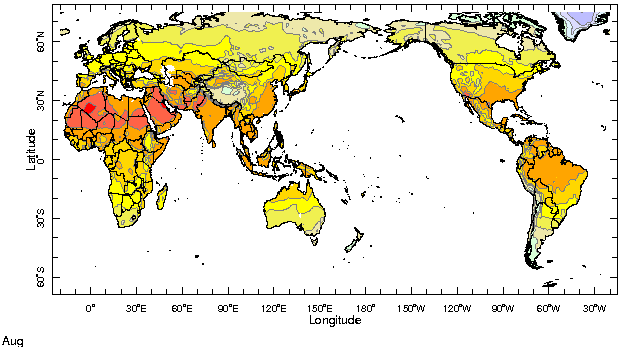|
IRI Climate Digest
September 2006
August Global Climate Summary
Climatological Background
During August, monsoon systems which bring rains to West Africa, South Asia, and southwestern North America have reached their northernmost extent. In the southern hemisphere midlatitudes, winter conditions begin to wane by month's end.
Monthly Mean Temperature (1961-1990), data from the Climate Research
Unit, University of East Anglia


Monthly Mean Precipitation (1961-1990), data from the Climate Research
Unit, University of East Anglia


Temperatures
Temperatures in August were near to above the (1961-1990) 30-year normal in most places, the most notable exceptions being western and central Europe and central Siberia. In these regions, as well as in southern South America, and in the northern tier of the United States at the border with Canada, anomalies cooler than in the previous month signaled a marked change in tendency.
Temperature Difference from the 1961-1990 mean, with data
from NCEP Climate Prediction Center, CAMS.


Precipitation
The largest anomalies in precipitation were to be found, once again, in the Maritime Continent region, where wetter-than-normal conditions in the western equatorial Pacific were contrasted by drier-than-normal conditions over equatorial regions of Indonesia and Malaysia. Wet anomalies in the 90th percentile were accompanied by cold surface air temperatures in western and central Europe. Dry anomalies characterized the monsoon region of the Caribbean, Central and northern South America, and southern China, while in other monsoon regions of the northern hemisphere the signal was mixed. In South Asia, areas including northwestern India and bordering Pakistan, and eastern India witnessed above-average precipitation, while in peninsular India rainfall was below average. Across Africa, rainfall was below normal at many locations, while at other locations, most notably in Ethiopia in the east, and in northern Burkina Faso and Niger in the west, abundant rainfall caused widespread flooding.
Precipitation Difference from 1979-2000 mean, with data
from NCEP Climate Prediction Center, CAMS-OPI.


Oceanic Conditions
August witnessed a warming of the equatorial Indian and central Pacific Oceans (see the IRI ENSO Update), and a cooling of the seas around the Indonesian archipelago. Predominantly warmer-than-average conditions persisted in the North Atlantic, especially in high latitudes, in the western North Pacific, and in the South Atlantic/Indian Oceans immediately to the south of the southern tip of Africa, in the region of the Agulhas Current.
Monthly Sea Surface Temperature Difference from the 1971-2000 mean,
with data from the Environmental Modeling Center, NCEP/NOAA.


Contents |
Special |
Impacts |
Climate |
Forecast
|

